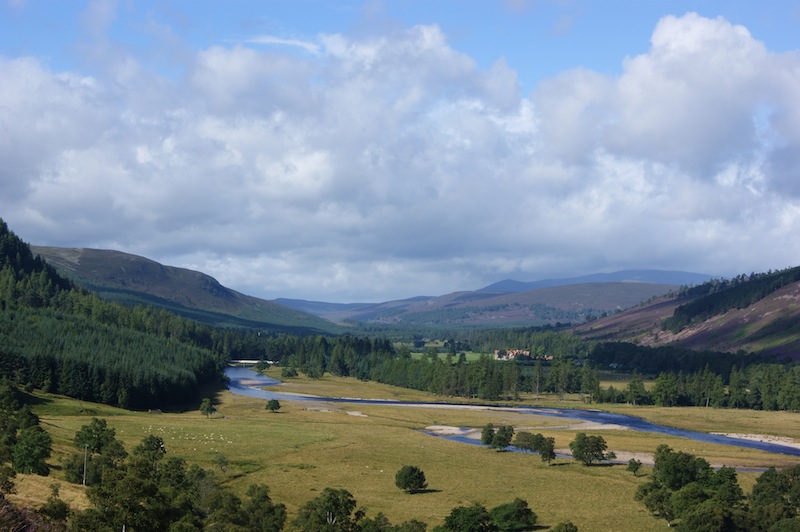With our much-discussed British weather being so hopelessly unreliable, it’s easy to make an excuse and head abroad on holiday. But on our visit to Braemar and Ballater in Scotland we found the sun and fell in love with Royal Deeside.
Braemar was stop number two, nestled in a landscape so spectacular I defy anyone not to fall in love with it. We’d driven from the royal village of Ballater, where we’d stayed for a couple of days, taking the A93 to drive deeper into the Cairngorms National Park. Around us were the dramatic hills and lush pine forests that are such a feature of this part of Scotland, the River Dee flowing lazily among them. It’s ideal countryside for lifting dampened spirits.

On the outskirts of Braemar stands a 17th century castle. It’s not as grand as some but it’s one of the few of the built tourist attractions in the village. Not that we were visiting the highest parish in the country, and one of the coldest villages in Britain, to visit historic houses. It was the outdoors that was the big draw, and we wouldn’t be alone. Hiking, mountain biking and golf draw tens of thousands to the region every year.
The base for our stay was the Invercauld Arms Hotel on the edge of the village, which looked grand from the outside but was faded and tatty in parts inside – at least during our stay. It was populated mainly by pensioners on coach tours.
The village itself is split in two by the thundering, hypnotic river known as the Clunie Water. According to legend, King Malcolm III of Scotland built a wooden bridge across it back in the 11th century and constructed Kindrochit Castle on the west bank. A jumbled collection of ruins are all that remain of the latter today and it’s impossible to imagine what it would’ve looked like.

Crossing to the east we found the grounds where the Highland Games are held every year, a popular destination with the royals on their summer holidays.
The next morning we went further afield, discovering yet more spectacular landscapes. The area has 24 mountains that rise to more than 3,000ft – known as Munros – as well as plentiful wildlife including red squirrels, deer and golden eagles. Much to Graham’s delight we spotted a red squirrel and had to stop the car for a closer look, so rare are they today in Britain.
We were aiming for the Mar Lodge Estate, owned nowadays by the National Trust for Scotland. We drove past the grand house, once the summer home of the Duke of Fife and his wife, a granddaughter of Queen Victoria, both of whom were known for their lavish entertainments and hospitality. The building looked as good as new, which isn’t surprising because it had to be restored after a terrible fire in 1991. There are over 200km of walks in the hills and valleys that make up the estate and we wanted to complete a couple of them.

The Linn of Dee was our first port of call, a stunning rock formation on the River Dee. As it flows down through the Cairngorms, the river gets caught up at a gorge near a stone bridge, a spectacular geological feature. Beyond, the Dee spreads out wide and shallow through the trees. A little memorial stands nearby, marking the point where two children drowned in 1927.
We followed the course of the river through the pine woods, emerged near where the River Lui meets the Dee and then followed the path upstream. We passed a couple of recent additions to the river – a concrete weir built by Canadian lumberjacks who worked there felling timber for the war effort during the Second World War, and an unsuccessful and now abandoned salmon ladder built to help fish journey upstream. Just beyond, the Lui tumbled down the hillside over a pretty waterfall.
Making our way back down to the car park, we found the stone remains of long-abandoned settlements. Back in the 18th century, ruthless landlords cleared villages to make way for more profitable timber plantations and some of these tragic ghost villages are visible at Glen Lui and Glen Dee.

We jumped in the car and headed back down the valley to the Linn of Quoich, which was quieter but perhaps more impressive. We took the path, passing a boarded-up cottage and a family playing in the river, and walked upstream until we found the Linn itself. Here again the water had carved its way through the rocks in spectacular fashion. From a bridge we could see the Punch Bowl, a hole in the rock through which the river flows. According to legend, it was created by the Earl of Mar pouring a particularly heady spirit into the stone to toast the Jacobite cause in 1715.
Beyond, the river sped its way down the hillside through yet more beautiful scenery and verdant woodland. We left full of awe.
Of an evening, we took it easy. But then Braemar isn’t exactly the nightlife centre of Scotland. We had a pleasant meal at the friendly Moorfield House Hotel and another night ate at The Gathering House Bistro. We drank a few pints at our hotel and made sure we took to the streets late at night to catch the starry skies – something we never see in light-polluted London.
As we drove away from Braemar the next day, I was reminded that Royal Deeside may not have the dramatic peaks of the Alps but this mountainous region is just as stunning in its own way.

